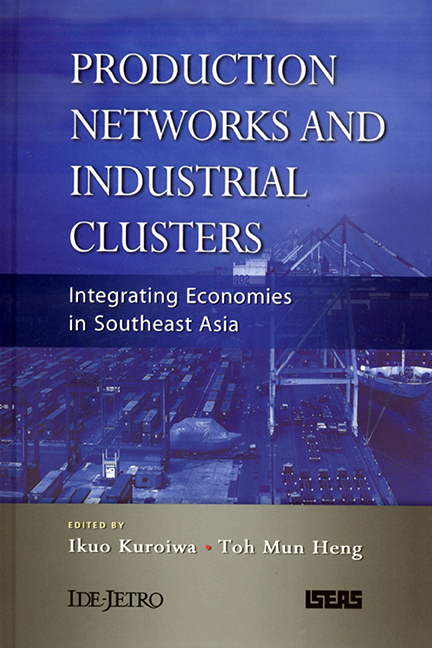Book contents
- Frontmatter
- Contents
- List of Tables
- List of Figures
- Preface
- Acknowledgements
- Contributors
- 1 Introduction
- I Overview of the Production Networks and Industrial Clusters in Southeast Asia
- II Case Studies
- 5 Industrial Clustering of Electronics Firms in Indonesia and Malaysia
- 6 The Biomedical Science (BMS) Industry in Singapore: Can It Plug into the Global Value Chain?
- 7 The Development of Automotive Industry Clusters and Production Networks in Thailand
- III Drivers for the Expanding Production Networks
- Index
5 - Industrial Clustering of Electronics Firms in Indonesia and Malaysia
from II - Case Studies
Published online by Cambridge University Press: 21 October 2015
- Frontmatter
- Contents
- List of Tables
- List of Figures
- Preface
- Acknowledgements
- Contributors
- 1 Introduction
- I Overview of the Production Networks and Industrial Clusters in Southeast Asia
- II Case Studies
- 5 Industrial Clustering of Electronics Firms in Indonesia and Malaysia
- 6 The Biomedical Science (BMS) Industry in Singapore: Can It Plug into the Global Value Chain?
- 7 The Development of Automotive Industry Clusters and Production Networks in Thailand
- III Drivers for the Expanding Production Networks
- Index
Summary
INTRODUCTION
Foreign-driven electronics manufacturing evolved in Southeast Asia when Japanese and American firms relocated assembly activities in Singapore, Malaysia and Philippines in the 1960s. Thailand from the 1970s, Indonesia from the 1980s and Vietnam from the late 1990s have subsequently become important electronics assembly bases. While there is consensus that Singapore has experienced integrated operations with specialization in technology-intensive high value added activities such as design, regional customization and wafer fabrication, there are still doubts over the direction electronics manufacturing has headed in the remaining part of Southeast Asia.
In addition, while considerable accounts exist on the positive role of foreign firms in generating employment and exports in Indonesia (Audretsch and Donnithorne 1957; Panglaykim 1983; Hill 1988, 1995, 1996; Sjoholm 2002; Okamoto and Sjoholm 2003) and Malaysia (Thoburn 1977; Rasiah 1994, 1995; Rasiah 2003a), little work compare how foreign and local firms are networked around institutions in these economies. Thus, this paper examines how foreign and local electronics firms are clustered and the consequent impact of this on firm-level technological intensities in Java-Batam in Indonesia, and Penang and Johor in Malaysia.
The systemic quad is used to analyse clustering in the industry in the states of Penang and Johor in Malaysia, and the islands of Java and Batam in Indonesia. Four policy pillars that require simultaneous coordination are identified in the systemic quad, viz., one, basic infrastructure to provide systemic stability and efficiency; two, high-tech infrastructure to provide systemic support for participation in learning and innovation; three, network cohesion to provide the systemic price, technological and social relationships necessary to drive interactive and interdependent coordination; and four, integration in global markets and value chains to provide the scale, scope and competition to drive learning and innovation.
The rest of the paper is organized as follows. Section II reviews past literature related to agglomeration economies and provides the justification for using the systemic quad as the approach for evaluating clustering in the electronics industry in Malaysia and Indonesia. Section III presents the methodology used and breakdown of data collected from Penang, Johor, and Java and Batam. Section IV examines the state of development of the four pillars that drive systemic synergies in the three regions from the two economies. Section V assesses the impact of these developments on technological capabilities and knowledge complexities. Section VI finishes with the conclusions.
- Type
- Chapter
- Information
- Production Networks and Industrial ClustersIntegrating Economies in Southeast Asia, pp. 127 - 157Publisher: ISEAS–Yusof Ishak InstitutePrint publication year: 2008



